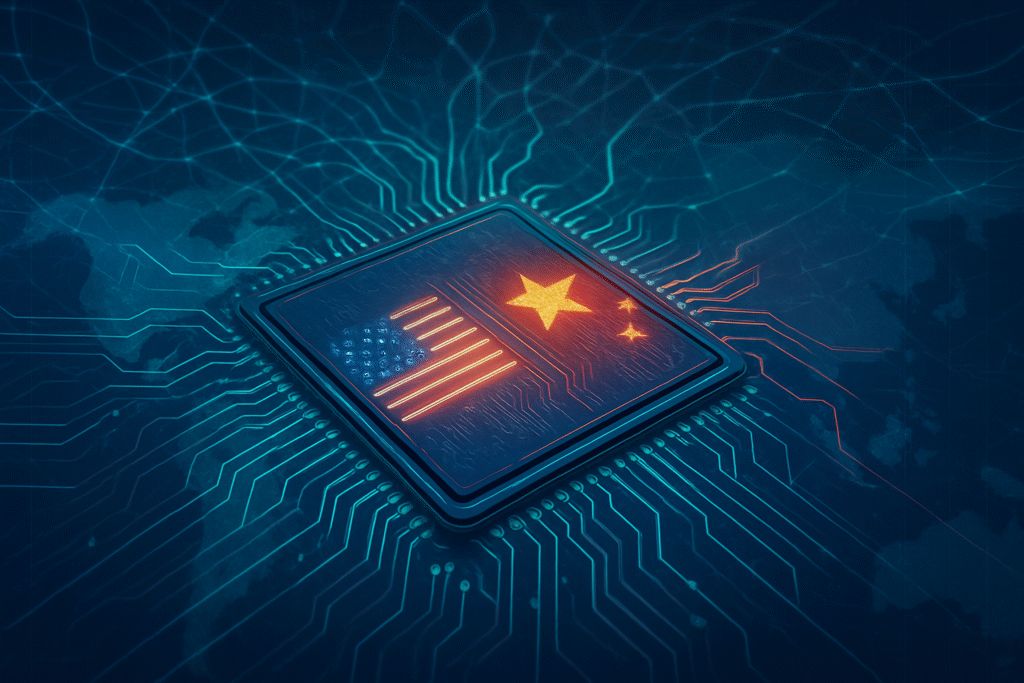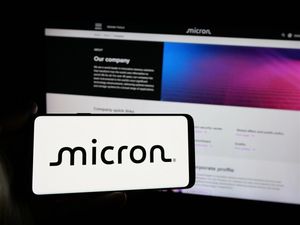
The ongoing technological rivalry between the United States and China has reached a fever pitch, with Washington implementing a series of increasingly stringent export restrictions aimed at curbing Beijing's access to advanced semiconductor technology. These measures, primarily driven by U.S. national security concerns, seek to impede China's military modernization and maintain American technological superiority in critical areas like advanced computing and artificial intelligence. The immediate fallout includes significant disruptions to global supply chains, financial pressures on leading U.S. chipmakers, and a forceful push for technological self-reliance within China's burgeoning tech sector.
The latest wave of restrictions, culminating in actions through late September and October 2025, has dramatically reshaped the landscape for global chip manufacturing and trade. From adjusting performance density thresholds to blacklisting hundreds of Chinese entities and even introducing controversial revenue-sharing conditions for certain chip sales, the U.S. strategy signals a determined effort to create a "chokehold" on China's high-tech ambitions. While intended to slow China's progress, these aggressive policies are also inadvertently accelerating Beijing's resolve to develop its own indigenous semiconductor ecosystem, setting the stage for a more fragmented and competitive global technology arena.
Unpacking the Technical Tightening: A Closer Look at the New Controls
The U.S. Bureau of Industry and Security (BIS) has systematically tightened its grip on China's access to advanced semiconductors and manufacturing equipment, building upon the foundational controls introduced in October 2022. A significant update in October 2023 revised the original rules, introducing a "performance density" parameter for chips. This technical adjustment was crucial, as it aimed to capture a broader array of chips, including those specifically designed to circumvent earlier restrictions, such as Nvidia's (NASDAQ: NVDA) A800/H800 and Intel's (NASDAQ: INTC) Gaudi2 chips. Furthermore, these restrictions extended to companies headquartered in China, Macau, and other countries under U.S. arms embargoes, affecting an additional 43 nations.
The escalation continued into December 2024, when the BIS further expanded its restricted list to include 24 types of semiconductor manufacturing equipment and three types of software tools, effectively targeting the very foundations of advanced chip production. A controversial "AI Diffusion Rule" was introduced in January 2025 by the outgoing Biden administration, mandating a worldwide license for the export of advanced integrated circuits. However, the incoming Trump administration quickly announced plans to rescind this rule, citing bureaucratic burdens. Despite this, the Trump administration intensified measures by March 2025, blacklisting over 40 Chinese entities and adding another 140 to the Entity List, severely curtailing trade in semiconductors and other strategic technologies.
The most recent and impactful developments occurred in late September and October 2025. The U.S. widened its trade blacklists, broadening export rules to encompass not only direct dealings with listed entities but also with thousands of Chinese companies connected through ownership. This move, described by Goldman Sachs analysts as a "large expansion of sanctions," drastically increased the scope of affected businesses. Concurrently, in October 2025, the U.S. controversially permitted Nvidia (NASDAQ: NVDA) and AMD (NASDAQ: AMD) to sell certain AI chips, like Nvidia's H20, to China, but with a contentious condition: these companies would pay the U.S. government 15 percent of their revenues from these sales. This unprecedented revenue-sharing model marks a novel and highly debated approach to export control, drawing mixed reactions from the industry and policymakers alike.
Corporate Crossroads: Winners, Losers, and Strategic Shifts
The escalating chip war has sent ripples through the global technology sector, creating a complex landscape of challenges and opportunities for various companies. U.S. chip giants, while initially facing significant revenue losses from restricted access to the lucrative Chinese market, are now navigating a new reality. Companies like Nvidia (NASDAQ: NVDA) and AMD (NASDAQ: AMD) have been compelled to design "de-tuned" chips specifically for the Chinese market to comply with export controls. While the recent conditional approval for sales like Nvidia's H20 offers a partial lifeline, the 15% revenue-sharing requirement is a novel imposition that could set a precedent and impact future profitability. Analysts had previously projected annual losses of $83 billion in sales and 124,000 jobs for U.S. firms due to the restrictions, highlighting the substantial financial risks involved.
On the Chinese front, the restrictions have created immense pressure but also spurred an unprecedented drive for domestic innovation. Companies like Huawei (SHE: 002502) have emerged as central players in China's self-sufficiency push. Despite being on the U.S. Entity List, Huawei, in partnership with SMIC (HKG: 0981), successfully developed an advanced 7nm chip, a capability the U.S. controls aimed to prohibit. This breakthrough underscored China's resilience and capacity for indigenous advancement. Beijing is now actively urging major Chinese tech giants such as ByteDance and Alibaba (NYSE: BABA) to prioritize domestic suppliers, particularly Huawei's Ascend chips, over foreign alternatives. Huawei's unveiling of new supercomputing systems powered by its Ascend chips further solidifies its position as a viable domestic alternative to Nvidia and Intel in the critical AI computing space.
The competitive landscape is rapidly fragmenting. While U.S. companies face reduced market access, they also benefit from government support aimed at bolstering domestic manufacturing through initiatives like the CHIPS Act. However, the long-term risk for U.S. firms is the potential for Chinese companies to "design out" U.S. technology entirely, leading to a diminished market share and destabilizing the U.S. semiconductor ecosystem. For European and Japanese equipment manufacturers like ASML (AMS: ASML), the pressure from the U.S. to align with export controls has created a delicate balancing act between maintaining access to the Chinese market and adhering to allied policies. The recent Dutch government seizure of Nexperia, a Dutch chipmaker with Chinese ownership, exemplifies the intensifying geopolitical pressures affecting global supply chains and threatening production halts in industries like automotive across Europe and North America.
Global Reverberations: The Broader Significance of the Chip War
The escalating US-China chip war is far more than a trade dispute; it is a pivotal moment that is profoundly reshaping the global technological landscape and geopolitical order. These restrictions fit into a broader trend of technological decoupling, where nations are increasingly prioritizing national security and economic sovereignty over unfettered globalization. The U.S. aims to maintain its technological leadership, particularly in foundational areas like AI and advanced computing, viewing China's rapid advancements as a direct challenge to its strategic interests. This struggle is not merely about chips but about who controls the future of innovation and military capabilities.
The impacts on global trade are significant and multifaceted. The restrictions have introduced considerable volatility into semiconductor supply chains, leading to shortages and price increases across various industries, from consumer electronics to automotive. Companies worldwide, reliant on complex global networks for components, are facing increased production costs and delays. This has prompted a strategic rethinking of supply chain resilience, with many firms looking to diversify their sourcing away from single points of failure. The pressure on U.S. allies, such as the Netherlands and Japan, to implement similar export controls further fragments the global supply chain, compelling companies to navigate a more balkanized technological world.
Concerns extend beyond economic disruption to potential geopolitical instability. China's retaliatory measures, such as weaponizing its dominance in rare earth elements—critical for semiconductors and other high-tech products—signal Beijing's willingness to leverage its own strategic advantages. The expansion of China's rare earth export controls in early October 2025, requiring government approval for designated rare earths, prompted threats of 100% tariffs on all Chinese goods from U.S. President Donald Trump, illustrating the potential for rapid escalation. This tit-for-tat dynamic risks pushing the world towards a more protectionist and confrontational trade environment, reminiscent of Cold War-era technological competition. This current phase of the chip war dwarfs previous AI milestones, not in terms of a specific breakthrough, but in its systemic impact on global innovation, supply chain architecture, and international relations.
The Road Ahead: Future Developments and Expert Predictions
The trajectory of the US-China chip war suggests a future characterized by continued technological decoupling, intensified competition, and a relentless pursuit of self-sufficiency by both nations. In the near term, we can expect further refinements and expansions of export controls from the U.S. as it seeks to close any remaining loopholes and broaden the scope of restricted technologies and entities. Conversely, China will undoubtedly redouble its efforts to bolster its domestic semiconductor industry, channeling massive state investments into research and development, fostering local talent, and incentivizing the adoption of indigenous hardware and software solutions. The success of Huawei (SHE: 002502) and SMIC (HKG: 0981) in producing a 7nm chip demonstrates China's capacity for rapid advancement under pressure, suggesting that future breakthroughs in domestic chip manufacturing and design are highly probable.
Long-term developments will likely see the emergence of parallel technology ecosystems. China aims to create a fully self-reliant tech stack, from foundational materials and manufacturing equipment to advanced chip design and AI applications. This could lead to a scenario where global technology standards and supply chains diverge significantly, forcing multinational corporations to operate distinct product lines and supply chains for different markets. Potential applications and use cases on the horizon include advancements in China's AI capabilities, albeit potentially at a slower pace initially, as domestic alternatives to high-end foreign chips become more robust. We might also see increased collaboration among U.S. allies to fortify their own semiconductor supply chains and reduce reliance on both Chinese and potentially over-concentrated U.S. production.
However, significant challenges remain. For the U.S., maintaining its technological edge while managing the economic fallout on its own companies and preventing Chinese retaliation will be a delicate balancing act. For China, the challenge lies in overcoming the immense technical hurdles of advanced chip manufacturing without access to critical Western tools and intellectual property. Experts predict that while the restrictions will undoubtedly slow China's progress in the short to medium term, they will ultimately accelerate its long-term drive towards technological independence. This could inadvertently strengthen China's domestic industry and potentially lead to a "designing out" of U.S. technology from Chinese products, eventually destabilizing the U.S. semiconductor ecosystem. The coming years will be a test of strategic endurance and innovative capacity for both global superpowers.
Concluding Thoughts: A New Era of Tech Geopolitics
The escalating US-China chip war, marked by increasingly stringent export restrictions and retaliatory measures, represents a watershed moment in global technology and geopolitics. The key takeaway is the irreversible shift towards technological decoupling, driven by national security imperatives. While the U.S. aims to slow China's military and AI advancements by creating a "chokehold" on its access to advanced semiconductors and manufacturing equipment, these actions are simultaneously catalyzing China's fervent pursuit of technological self-sufficiency. This dynamic is leading to a more fragmented global tech landscape, where parallel ecosystems may ultimately emerge.
This development holds immense significance in AI history, not for a specific algorithmic breakthrough, but for fundamentally altering the infrastructure upon which future AI advancements will be built. The ability of nations to access, design, and manufacture advanced chips directly correlates with their capacity for leading-edge AI research and deployment. The current conflict ensures that the future of AI will be shaped not just by scientific progress, but by geopolitical competition and strategic industrial policy. The long-term impact is likely a bifurcated global technology market, increased innovation in domestic industries on both sides, and potentially higher costs for consumers due to less efficient, duplicated supply chains.
In the coming weeks and months, observers should closely watch several key indicators. These include any further expansions or modifications to U.S. export controls, particularly regarding the contentious revenue-sharing model for chip sales to China. On China's side, monitoring advancements from companies like Huawei (SHE: 002502) and SMIC (HKG: 0981) in domestic chip production and AI hardware will be crucial. The responses from U.S. allies, particularly in Europe and Asia, regarding their alignment with U.S. policies and their own strategies for supply chain resilience, will also provide insights into the future shape of global tech trade. Finally, any further retaliatory measures from China, especially concerning critical raw materials or market access, will be a significant barometer of the ongoing escalation.
This content is intended for informational purposes only and represents analysis of current AI developments.
TokenRing AI delivers enterprise-grade solutions for multi-agent AI workflow orchestration, AI-powered development tools, and seamless remote collaboration platforms.
For more information, visit https://www.tokenring.ai/.





